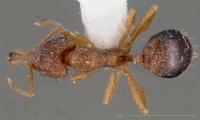Strumigenys dora
| Strumigenys dora | |
|---|---|

| |
| Scientific classification | |
| Kingdom: | Animalia |
| Phylum: | Arthropoda |
| Class: | Insecta |
| Order: | Hymenoptera |
| Family: | Formicidae |
| Subfamily: | Myrmicinae |
| Tribe: | Attini |
| Genus: | Strumigenys |
| Species: | S. dora |
| Binomial name | |
| Strumigenys dora Fisher, 2000 | |
The few records of this species were taken from litter samples in savanna and tropical dry forest.
Identification
Bolton (2000) - A member of the dora complex in the Strumigenys grandidieri-group. Among species of the grandidieri-group with a 2-dentate apical fork, dora is the only one that has the first gastral tergite and sternite densely punctate over the anterior halves or more of the sclerites, coupled with at least 3 pairs of hairs on the petiole dorsum.
Keys including this Species
Distribution
Distribution based on Regional Taxon Lists
Malagasy Region: Madagascar (type locality).
Distribution based on AntMaps
Distribution based on AntWeb specimens
Check data from AntWeb
Countries Occupied
| Number of countries occupied by this species based on AntWiki Regional Taxon Lists. In general, fewer countries occupied indicates a narrower range, while more countries indicates a more widespread species. |

|
Estimated Abundance
| Relative abundance based on number of AntMaps records per species (this species within the purple bar). Fewer records (to the left) indicates a less abundant/encountered species while more records (to the right) indicates more abundant/encountered species. |

|
Biology
Castes
Images from AntWeb
   
| |
| Paratype of Strumigenys dora. Queen (alate/dealate). Specimen code casent0005525. Photographer April Nobile, uploaded by California Academy of Sciences. | Owned by MCZ, Cambridge, MA, USA. |
Nomenclature
The following information is derived from Barry Bolton's Online Catalogue of the Ants of the World.
- dora. Strumigenys dora Fisher, in Bolton, 2000: 652 (w.q.) MADAGASCAR.
Unless otherwise noted the text for the remainder of this section is reported from the publication that includes the original description.
Description
Worker
Holotype. TL 3.2, HL 0.73, HW 0.57, CI 79, ML 0.37, MI 52, SL 0.46, SI 81, PW 0.36, AL 0.75. Characters of dora-complex. Mandibles almost straight and at full closure parallel. Apical fork of mandible with 2 spiniform teeth, without intercalary teeth or denticles. Mandible with 2 preapical teeth, situated in the apical third of the length; proximal preapical tooth longer than the distal. Upper scrobe margin ends, or at least becomes extremely indistinct, at about the level of the eye. Eye large, convex, and plainly visible in full-face view. Scape stout, curved near base, widest at about the midlength, the leading edge with a row of hairs which are slightly flattened or spoon-shaped apically. Cephalic dorsum with curved remiform to narrowly clavate ground-pilosity; the upper scrobe margin fringed with a row of hairs which are the same shape and size as those on the dorsum. Cephalic dorsum with 6 simple standing hairs arranged in a transverse row close to the occipital margin and a more anteriorly situated pair. Dorsum of head reticulate-punctate. Pronotal humeri rounded, the humeral hair stiffly projecting. Alitrunk dorsum with numerous standing simple hairs. Propodeal declivity with one pair of simple hairs situated at centre of lateral margin. Alitrunk dorsum with small curved narrowly clavate ground-pilosity. Dorsum of alitrunk in outline shallowly convex anteriorly and more or less flat posteriorly; posterior portion of mesonotum slightly depressed below the anterior margin of the propodeum, the metanotal groove represented by a distinct impression. Anterior mesonotum without a distinct carina above the mesothoracic spiracle. Propodeal spines triangular, spongiform; propodeal lamella narrow. Alitrunk dorsum and sides reticulate-punctate, katepisternum smooth and shiny. Petiole node in dorsal view reticulate-punctate and approximately as long as broad. Postpetiole disc reticulate-punctate. Spongiform appendages of petiole and postpetiole absent, except for a spongiform collar on posterior margin of postpetiole. First gastral tergite and sternite densely punctate over anterior half or more of the sclerites; basigastral costulae short and obscured by the punctate sculpture. Dorsum of petiole with at least 3 pairs of standing hairs. Dorsal surfaces of postpetiole and gaster with stout standing hairs which are weakly swollen apically. Colour chocolate brown.
Type Material
Holotype worker, Madagascar: 18 km. NW Betroka, 23°9'48"S, 45°58'7"E, 825 m., 24-29.xi.1994, savanna #.17216 (Ivie & Pollock) (Museum of Comparative Zoology).
Paratypes. 2 queens (alate and dealate) with same data as holotype but coded .15822, 16453 (The Natural History Museum, MCZ).
References
- Fisher, B.L. 2000. The Malagasy fauna of Strumigenys. Pp. 612-696 in: Bolton, B. 2000. The ant tribe Dacetini. Memoirs of the American Entomological Institute. 65:1-1028. (page 652, worker described)
References based on Global Ant Biodiversity Informatics
- Bolton, B. 2000. The Ant Tribe Dacetini. Memoirs of the American Entomological Institute 65
- Fisher B. L. 2003. Formicidae, ants. Pp. 811-819 in: Goodman, S. M.; Benstead, J. P. (eds.) 2003. The natural history of Madagascar. Chicago: University of Chicago Press, xxi + 1709 pp.

